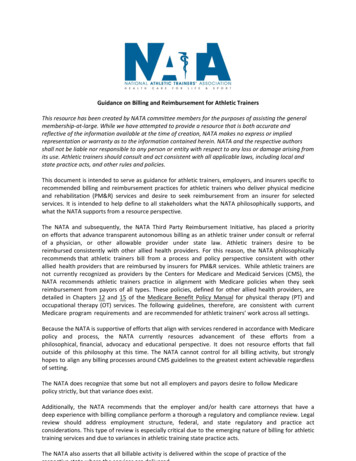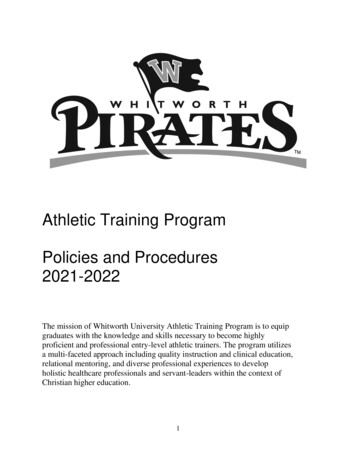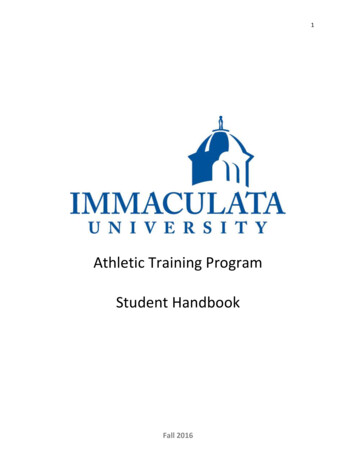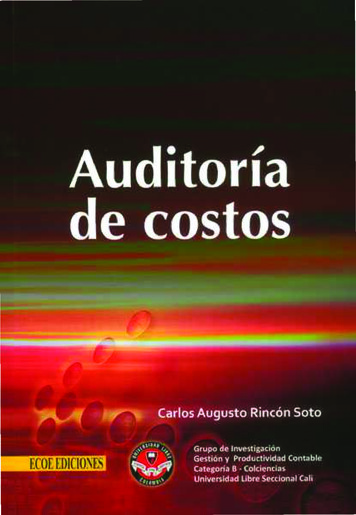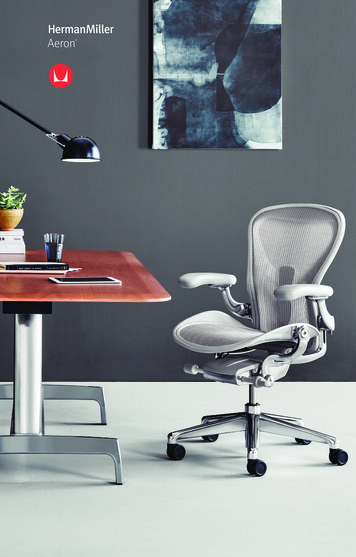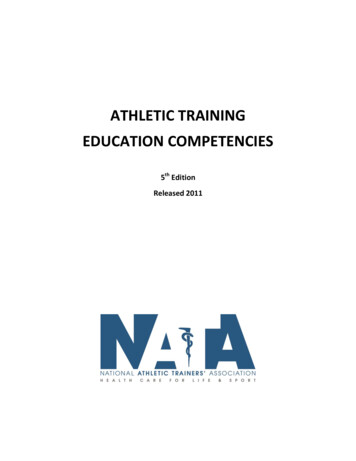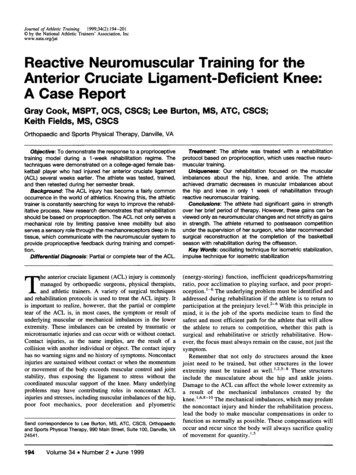
Transcription
Journal of Athletic Training 1999;34(2): 194-201C by the National Athletic Trainers' Association, Incwww.nata.org/jatReactive Neuromuscular Training for theAnterior Cruciate Ligament-Deficient Knee:A Case ReportGray Cook, MSPT, OCS, CSCS; Lee Burton, MS, ATC, CSCS;Keith Fields, MS, CSCSOrthopaedic and Sports Physical Therapy, Danville, VAObjective: To demonstrate the response to a proprioceptivetraining model during a 1-week rehabilitation regime. Thetechniques were demonstrated on a college-aged female basketball player who had injured her anterior cruciate ligament(ACL) several weeks earlier. The athlete was tested, trained,and then retested during her semester break.Background: The ACL injury has become a fairly commonoccurrence in the world of athletics. Knowing this, the athletictrainer is constantly searching for ways to improve the rehabilitative process. New research demonstrates that rehabilitationshould be based on proprioception. The ACL not only serves amechanical role by limiting passive knee mobility but alsoserves a sensory role through the mechanoreceptors deep in itstissue, which communicate with the neuromuscular system toprovide proprioceptive feedback during training and competition.Differential Diagnosis: Partial or complete tear of the ACL.Treatment: The athlete was treated with a rehabilitationprotocol based on proprioception, which uses reactive neuromuscular training.Uniqueness: Our rehabilitation focused on the muscularimbalances about the hip, knee, and ankle. The athleteachieved dramatic decreases in muscular imbalances aboutthe hip and knee in only 1 week of rehabilitation throughreactive neuromuscular training.Conclusions: The athlete had significant gains in strengthover her brief period of therapy. However, these gains can beviewed only as neuromuscular changes and not strictly as gainsin strength. The athlete returned to postseason competitionunder the supervision of her surgeon, who later recommendedsurgical reconstruction at the completion of the basketballseason with rehabilitation during the offseason.Key Words: oscillating technique for isometric stabilization,impulse technique for isometric stabilization(energy-storing) function, inefficient quadriceps/hamstringratio, poor acclimation to playing surface, and poor proprioception. 1-6 The underlying problem must be identified andaddressed during rehabilitation if the athlete is to return toparticipation at the preinjury level.26 With this principle inmind, it is the job of the sports medicine team to find thesafest and most efficient path for the athlete that will allowthe athlete to return to competition, whether this path issurgical and rehabilitative or strictly rehabilitative. However, the focus must always remain on the cause, not just thesymptom.Remember that not only do structures around the kneejoint need to be trained, but other structures in the lowerextremity must be trained as well.12,5-8 These structuresinclude the musculature about the hip and ankle joints.Damage to the ACL can affect the whole lower extremity asa result of the mechanical imbalances created by theknee.1 6,8-4O The mechanical imbalances, which may predatethe noncontact injury and hinder the rehabilitation process,lead the body to make muscular compensations in order tofunctionas normally as possible. These compensations willSend correspondence to Lee Burton, MS, ATC, CSCS, Orthopaedicrecur since the body will always sacrifice qualityoccurandand Sports Physical Therapy, 990 Main Street, Suite 100, Danville, VA24541.of movement for quantity.",5T he anterior cruciate ligament (ACL) injury is commonlymanaged by orthopaedic surgeons, physical therapists,and athletic trainers. A variety of surgical techniquesand rehabilitation protocols is used to treat the ACL injury. Itis important to realize, however, that the partial or completetear of the ACL is, in most cases, the symptom or result ofunderlying muscular or mechanical imbalances in the lowerextremity. These imbalances can be created by traumatic ormicrotraumatic injuries and can occur with or without contact.Contact injuries, as the name implies, are the result of acollision with another individual or object. The contact injuryhas no warning signs and no history of symptoms. Noncontactinjuries are sustained without contact or when the momentumor movement of the body exceeds muscular control and jointstability, thus exposing the ligament to stress without thecoordinated muscular support of the knee. Many underlyingproblems may have contributing roles in noncontact ACLinjuries and stresses, including muscular imbalances of the hip,poor foot mechanics, poor deceleration and plyometric194Volume 34*Number 2*June 1999
Figure 1. Certified athletic trainer performing computer dynamometer test.Attention must be given equally in 2 areas that are sometimes overlooked: sport-specific function and motor learning.In order to understand sport-specific function, the clinicianmust identify the demands of the sport and the abilities of theathlete. Functional exercise programs allow the physical therapist and the athletic trainer to combine conditioning andrehabilitation with activities that increase motor pathwayfunction and reaction time, thus restoring efficient movementthrough motor programs. An example of this is an exerciseprogram known as reactive neuromuscular training (RNT),first introduced by Voight and Cook5 and the basis for ourACL exercise regime, which emphasizes kinesthetic or proprioceptive input and places less emphasis on verbal and visualinput.REACTIVE NEUROMUSCULAR TRAINING-Figure 2. Physical therapist performing modified Thomas Test.without a good mobility base, then compensations will belearned and motor programs will be altered. However, with agood mobility base, the correct movements will be learned andwill become automatic." 5The theory behind RNT is to emphasize activities designedto minimize the need for verbal and visual instruction from thephysical therapist or athletic trainer. This type of training asks PRESENTATION OF THE CASEonly that the athlete respond to a stimulus created by an outsideOur subject was an ACL-deficient, college-aged femaleforce (eg, being pulled by elastic tubing). The initial emphasisis not on altering strength, but rather on dynamic stability and basketball player. Her rehabilitative training regimen followedproprioception, which can be defined as awareness of posture, a progression adapted from the theory of RNT. The athletemovement, and changes in equilibrium and the knowledge of began her rehabilitative program with her collegiate certifiedposition, weight, and resistance of objects in relation to the athletic trainer before her visit to our clinic. The collegiatebody, respectively.1' This type of training focuses on appro- athletic trainer had succeeded in helping her regain full, activepriate body positioning and posture to promote proper dynamic range of motion and basic strength; however, her ballisticmuscular stabilization during functional activities, thus allow- movements were awkward.We were asked by her collegiate athletic trainer to evaluateing for the control of abnormal joint translation during functional activities." 5 These activities are designed to emphasize and treat her over the semester break. The athlete already hada solid rehabilitation foundation before she began her workquality of movement before quantity of movement.The goal of phase I is to successfully stimulate a proprio- with us due to her program with her collegiate athletic trainer.ceptive reaction for a certain number of repetitions. This We will focus only on the particular treatment we provided inshould not be attempted until active range of motion is our clinic and the results we achieved over the athlete'srestored. If proprioception and stability training are attempted semester break.Journal of Athletic Training195
Table 1. Computer Dynamometer Test Comparing Right and LeftLower Extremities, December 19 (Refer to Table 7)Hip medial rotationHip adductionKnee flexion(lateral rotation)Knee extensionR, right leg (the involved*Left (kg)Right (kg)13.6124.4916.788.1619.9613.61-40 R*-18 R-19 R26.76side).21.77-19 RDeficit (%)The athlete was injured during a basketball game on November 7. She reported that her knee twisted and she felt a"pop." The initial evaluation by the orthopaedist revealedsubstantial instability and a positive Lachman from a probableACL tear. The athlete was braced and treated acutely, thenallowed to return to activities as tolerated. The goals set by theathlete's orthopaedic surgeon and collegiate athletic trainerwere to have the athlete ready for postseason play with thepossibility of reconstructive surgery afterward. We were informed that we would have approximately 5 visits to work withthe athlete over the holiday season.The athlete's initial rehabilitation program from her collegiate athletic trainer included a variety of strengthening andconditioning activities. On odd days, her workouts consisted ofbilateral leg presses, short-arc extensions, lunges, step-ups, Figure 3. Athlete performing OTIS.eyes-closed unilateral squats, Fitter (Fitter International, Inc,Calgary, AB, Canada) or slide, tubing, and lazy-S running. Oneven days, the workouts consisted of squats, leg extensions andcurls (including isokinetics), walking lunges, step-ups, andlazy-circle running. In addition she was biking, stair climbing,and jogging for cardiorespiratory conditioning.EVALUATION AND TESTINGOn the first visit, we performed a complete evaluation andassessment, including computerized eccentric contractionbreak tests (J-Tech Power Tracker, Heber City, UT) bilaterallyto identify any strength imbalances (Figure 1). We found nopoint tenderness or lack of range of motion but did find 1 cmof joint effusion when compared bilaterally at the joint lines.The Lachman and anterior drawer sign revealed moderate Figure 4. Athlete performing ITIS.visible joint laxity. A modified Thomas test was performedbilaterally to evaluate hip mobility (Figure 2). This test is spine), and the other leg is relaxed off the table edge. If theperformed by having the athlete sit on the edge of a table; withthe support of the athletic trainer or physical therapist, the knee range of motion is less than 900, the rectus femorisathlete lies back with both knees drawn up to the chest. One muscle is tight; if the thigh remains elevated ( 00 hipknee is held to the chest (locking out the pelvis and lumbar extension) above the table, then the iliopsoas muscle is tight. Ifthe thigh and lower leg fall or turn out laterally (externalrotation of the tibia or abduction of the femur), the iliotibialTable 2. Complementary Home Exercise Programband may be tight. '12 As confirmed by a computer manualExerciseSetsRepetitions or Timemuscle test, this athlete was found to have a tight iliotibial band330 s, increase to 1.5 min on the involved side, which is usually indicative of adductorSingle-leg jump ropeweakness.315 repetitionsSingle-leg squatsResisted scissored running315 sFunctional testing was performed by means of resistedResisted heel slide (lower315 repetitionsmedial-lateral weight-shift running. The ability to load andleg internally rotated)unload the extremities was compared bilaterally. This test was196Volume 34 * Number 2 * June 1999
done in order to simulate change-of-direction movements onthe court without having to actually perform the movement ona gymnasium floor. Foot contacts were counted over a 15second period and compared medially and laterally. Closedchain kinesthetic awareness was assessed through a timed,unilateral stance with eyes open and then with eyes closed.Isometric endurance was assessed by a timed, unilateral 90degree isometric wall squat. A single-leg hop test was used totest strength and power; the distance jumped by each leg wasmeasured.These functional tests revealed no significant deficits between the involved and the uninvolved sides. We used 10% asthe cutoff point for a significant difference between theextremities. This percentage is commonly used, because itallows for unilateral limb dominance.'3"4 The fact that functional tests revealed no significant deficits with bilateralcomparison was interesting, considering the results of thecomputer dynamometer test (Table 1). This test confirms thebody's ability, by sacrificing quality movements in order toperform effectively, to make muscular compensations. If wehad not analyzed the individual components through thecomputerized dynamometry, we would have overlooked someof the areas that could have been serving as weak links andcould have led to microtraumatic changes over time.The computer dynamometer test involved hip medial andlateral rotation, hip abduction and adduction, hip flexion andextension, and knee flexion (laterally rotated) and extension.These movements were tested by performing an eccentricbreak test on the muscle or muscle group. Many muscles in theJI,Figure 6 Athlete performing resistive running with a posteriorweight shift (XTS, CDM Sports, Fort Worth, T().lower extremity contract eccentrically to help stabilize the kneeand hip. The purpose of this type of muscle testing is to isolatethese muscles eccentrically, while also providing a comparisonbetween the strength of the muscles surrounding the knee andthose surrounding the hip. If the hip movements had not beentested, major weaknesses and muscular imbalances that canincrease stress on the knee might have been overlooked. Theathlete might have returned to competition with significant hipweaknesses.The computer dynamometer results revealed significantweakness ( 10%) when compared bilaterally in hip medialrotation, hip adduction, and knee flexion (laterally rotated) andknee extension (Table 1). Thus, there was a strength imbalancewith regard to medial and lateral stability. (The other musclestested revealed no significant weaknesses.)REHABILITATION AND TRAININGFigure 5. Athlete performing OTIS in plantar-flexed position.Our main focus was to resolve the noted deficits about theinvolved extremity, while improving knee joint stability, sincefull mobility had already been obtained. The athlete had alsobeen training mostly in an anterior-posterior plane usingisokinetics. Our goal was to now advance her training, gearingit toward multiplanar and functional activities, while continu-Journal of Athletic Training197
Figure 7. Athlete performing resistive scissored running with aposterior weight shift.Figure 8. Athlete performing resistive scissored running with alateral weight shift.ing to focus on the deficits at hand. We sought to accomplishthis through a progression of RNT. It was imperative that ourexercises be specific enough to address the imbalances at hand,yet effective during the limited time allotted. We decided thatan interval program would accommodate both the athlete'sfunctional needs and her conditioning concerns. In addition tothe clinic program, a complementary home exercise programwas established (Table 2).Our first task was to promote isometric stabilization forstatic control and posture with the goal of advancing todynamic stabilization. This was done to decrease the body'sneed to compensate for quality movements. Two types ofstability techniques, described by Voight and Cook,s werechosen to stimulate mechanoreceptor and muscle spindlefunction in a closed chain situation. The first technique,oscillating technique for isometric stabilization (OTIS), incorporates short, rapid oscillatory movements of an uninvolvedbody part to promote isometric stabilization of the involvedbody part. This technique is accomplished by having the armspull elastic tubing fixed to the wall (Figure 3). This is helpfulbecause the involved leg does not initiate any movement, buthas only to react to weight shifting generated by arm move-ments, thus emphasizing the proprioceptive role of the lowerextremity.A complementary technique, impulse technique for isometric stabilization (ITIS), was performed with a plyoback trainingaid. ITIS provides for quick and repetitive loading and unloading or impulses within a short arc of movement (Figure 4). Thesame principle could be applied by throwing a medicine ballwith a partner. The correct posture and positioning are imperative so that the involved mechanoreceptors are appropriatelystimulated for joint proprioception.OTIS and ITIS techniques may be applied in differentdirections to elicit involvement from various muscle groups.For our athlete, based on the imbalances found on the tests, wefelt that directional emphasis would accommodate strengthening of the hip medial rotators, hip adductors, tibial medialrotators, and knee extendors. The applicable directions forthe OTIS and ITIS techniques place the involved extremityaway from the wall or rebounder with the foot at a 45-degreeangle. The athlete must overcome rotational forces in thisposition while focusing on the muscle weaknesses in orderto maintain proper posture and position. A foam roll addedunder the heel further increased musculature involvement in198Volume 34 * Number 2 * June 1999
Figure 10. Athlete performing plyotaps on Shuttle 2000 (Contemporary Design Co, Glacier, WA).Figure 9. Athlete performing resisted bounding with a lateralweight shift.order to maintain ankle, knee, and hip stability during theexercise (Figure 5).We then implemented exercises that were progressivelydynamic in nature to strengthen the hip and knee musculaturewhile maintaining the athlete's cardiorespiratory endurance.She was able to immediately begin resistance activities, such asrunning, bounding, and scissored running, due to the performance scores established on the functional tests. She performed these activities with medial-lateral resistance andanterior-posterior resistance (Figures 6-9). These types ofresistance focused on hip medial rotation, hip adduction, kneeflexion, and knee extension. We, however, focused more onmedial resistance activities in order to emphasize hip medialrotation and adduction, due to the computer dynamometryresults.The third aspect of her training incorporated progressiveplyometrics. These movements use the neuromuscular stretchreflex and require greater degrees of dynamic stability than thepreviously mentioned activities. Activities within this phasealso simulate the forces encountered during sport participation.They include plyometric demands, kinesthetic forces, andenergy systems demands. The athlete performed plyotaps, orjumping with a graded resistance (Figure 10). This exerciseemphasizes eccentric loading and vertical plyometrics. Theathlete's day-to-day training regimen is outlined in Tables 3-6(Figures 11 and 12).The fifth visit included the same activities as the fourth visit.The last visit was scheduled solely to retest and review anongoing home exercise program.Upon completion of our brief rehabilitation, the manualcomputer dynamometer muscle tests were repeated. No functional tests were performed because there were no functionaldeficits during the pretest. The dynamometry posttest revealedsome astonishing results: hip medial rotation on the involvedside went from being 40% deficient to only 13% deficient, andthe knee extension, knee flexion laterally rotated, and hipadduction deficits had resolved (Table 7).DISCUSSIONWe know from past research that improvements in truestrength may take several weeks to occur; however, there issome evidence to support substantial gains in what appearsto be strength by our subject. These gains often occur withinthe first 6 weeks with various forms of weight training. Thereason for these changes is most often attributed to neuromuscular changes, including better coordination and imTable 3. Training Regime for Day IExercise1) Walking: warm-up to 2.46 m/sjog on treadmill2) Flexibility routine onBackSystem33) Review of home programSetsRepetitions or Time15 min110 repetitions eachJournal of Athletic Training199
Table 4. Training Regime for Day 2SetsRepetitions or Time13 (4 directions)3 (4 directions)3 (4 directions)3315 min10 repetitions each30 repetitions30 repetitions15 s20 repetitions20 repetitions5 minExercise1)2)3)4)5)6)7)8)1Walking: warm-up to 2.46 m/s jog (interval jog between activities)Flexibility routine on BackSystem3ITIS unilateral in plantar flexionOTIS unilateral in plantar flexionResisted runningLeg press bilaterally, 8 cordsPlyotaps (eccentric loading) bilaterally, 8 cordsCool-down after 2.46 m/s jogTable 5. Training Regime for Day 3SetsExercise1)2)3)4)5)6)7)8)Walking warm-up to 2.46 m/s jog (interval jog between each activity)Flexibility routine on BackSystem3ITIS unilateral in plantar flexionOTIS unilateral in plantar flexionResisted boundingPlyotaps (eccentric loading) bilaterally, 8 cordsUnilateral wall squats, 90 knee flexionCool-down after 2.46 m/s jogRepetitions or Time5 min113 (4 directions)3 (4 directions)3 (4 directions)33110 repetitions each30 repetitions30 repetitions15 s20 repetitions20 repetitions5 minSetsRepetitions or Time13 (4 directions)3 (4 directions)3 (4 directions)335 min10 repetitions each30 repetitions30 repetitions15 s20 repetitions20 s5 minTable 6. Training Regime for Day 4Exercise1)2)3)4)5)6)7)8)Walking warm-up to 2.46 m/s jog (interval jog between each activity)Flexibility routine on BackSystem3ITIS unilateral in plantar flexionOTIS unilateral in plantar flexionResisted scissored runningPlyotaps (eccentric loading) bilaterally, 8 cordsUnilateral wall squats, 900 knee flexionCool-down after 2.46 m/s jog,--11proved recruitment. The human body has the inherent abilityto recognize and react to movements that it identifies asfamiliar or patterned, which may be stored in musclememory. The stability exercises that we chose for rehabilitation use similar movement patterns and allow the body toreact appropriately with little compensatory activity. Byimplementing appropriate purpose, posture, positioning, andpatterning, we can more efficiently affect the athlete's stateof functioning. Since we treated the athlete only over an-8-day period, her progress and testing results would seem toTable 7. Computer Dynamometer Test Comparing Right and LeftLower Extremities, December 27 (Refer to Table 1)Left (kg)Deficit (%)Right (kg)12.7026.3121.3210.8925.8521.32-13 R*31.75Knee extension* R, right leg (the involved side).29.03-9 RHip medial rotation*-C g lE '' ?isiCl , F' XHip adductionKnee flexion (lateral rotation)Figure 11. Athlete performing stretching routine on BackSystem3(BackSystem3, CDM Medical, Fort Worth, TX).200Volume 34 * Number 2 * June 1999-3 R0
.,td e s j.i.S;[.,.f ,reson competition. If these imbalances had not been identified,she would have continued to sacrifice knee stability to compensate for hip muscular imbalances. This might have led tomore knee and hip problems and a longer rehabilitation aftersurgery.The athlete did return to competition and completed asuccessful season. She continued to train throughout theremainder of the season using her home exercise program.At the end of the season, she underwent reconstruction andwas then rehabilitated by her collegiate athletic trainer. Theathlete had an excellent recovery after surgery with acontinuation of her previous rehabilitation protocol. Webelieve that the RNT techniques applied before surgeryhelped to eliminate some of the primary imbalances thatcould have have led to a more complicated and less activerecovery. Also, the athlete's diligent work ethic should begiven credit in collaboration with our training program. Shedid everything we asked of her and was extremely compliantwith her independent home program.R n .S-*.,.,*1 .is: .:s,*sREFERENCES@;s. :;, wrv. .W.S,.: .:, tFigure 12. Athlete performing unilateral wall squats.indicate neuromuscular adaptations and not just improvedstrength.The athlete already had a well-established rehabilitationprogram, focusing on uniplanar movements, such as flexionextension isokinetics and leg presses. Our focus was onmultiplanar movements, focusing on the hip musculatureimbalances. We felt that by shifting our focus to moremedial-lateral and rotational-type activities, we could place theathlete in a more functional position while addressing the noteddeficits.The ability to identify the hip muscular imbalances and thenuse a more multiplanar and sport-specific training modelprovided the athlete with a more solid foundation for postsea-1. Cook G. Functional exercise training. Presented at: Advances in ClinicalEducation of the North American Sports Medicine Institute; February6-8, 1998; Atlanta, GA.2. Baechle TR. Essentials of Strength Training and Conditioning. Champaign, IL: Human Kinetics; 1994.3. Taimela S, Kujala UM, Osterman K. Intrinsic risk factors and athleticinjuries. Sports Med. 1990;9:205-214.4. Beynnon BD, Johnson RJ. Anterior cruciate ligament injury rehabilitationin athletes: biomechanical considerations. Sports Med. 1996;22:54-64.5. Voight ML, Cook G. Clinical application of closed kinetic chain exercise.J Sport Rehabil. 1996;5:25-44.6. Voight ML, Tippett SR. Functional Progression for Sport Rehabilitation.Champaign, IL: Human Kinetics; 1995.7. Barrack RL, Skinner HB, Buckley SL. Proprioception in the anteriorcruciate deficient knee. Am J Sports Med. 1989;17:1-6.8. Friden T, Roberts D, Zatterstrom R, Lindstrand A, Moritz U. Proprioception in the nearly extended knee: measurements of position and movementin healthy individuals and in symptomatic anterior cruciate ligamentinjured patients. Knee Surg Sports Traumatol Arthrosc. 1996;4:217-224.9. MacDonald PB, Hedden D, Pacin 0, Sutherland K. Proprioception inanterior cruciate ligament-deficient and reconstructed knees. Am J SportsMed. 1996;24:774-778.10. Solomonow M, Baratta R, Zhou BH, et al. The synergistic action of theanterior cruciate ligament and thigh muscles in maintaining joint stability.Am J Sports Med. 1987; 15:207-213.11. Thomas CL. Taber's Cyclopedic Medical Dictionary. Philadelphia, PA:F.A. Davis; 1993.12. Cook G, Fields K, Burton L. Where football meets flexibility. Train Cond.1997;7:49-55.13. Bender JA, Pierson JK, Kaplan HM, Johnson AJ. Factors affecting theoccurrence of knee injuries. J Assoc Phys Ment Rehabil. 1964;18:130135.14. Peterson P, Petrick M, Connor H, Conklin D. Grip strength and handdominance: challenging the 10% rule. Am J Occup Ther. 1989;43:444447.Journal of Athletic Training201
athlete. Functional exercise programs allow the physical ther-apist and the athletic trainer to combine conditioning and rehabilitation with activities that increase motor pathway function and reaction time, thus restoring efficient movement through motor programs. An example of this i
